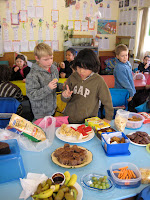
A teacher and a teacher aide from our school are part of a professional development programme called English Language Assistants (ELA). This programme provides training and professional development for teacher aides who are providing English language support to ESOL funded students, international students, new learners of English, new migrants and other students in need of English language support. The teacher aides are supported by a co-ordinating teacher.
The ELA programme was developed and written by Jannie van Hees, Faculty of Education, University of Auckland. The ELA course consists of 6 whole day workshops, one a month, 5 school visits, inter-workshop tasks and a morning for overall course evaluation and graduation.
The six workshops include the topics of language assistant effectiveness, developing and enriching concepts and language (first principles), developing and enriching concepts and language with a dual language student, scaffolding for language, effective reading to and with students and effective ways to develop students' writing.

The ELAs share their inter-workshop tasks with each other and discuss ideas. They look at new resources and learn many new skills and strategies to assist English language learners with their oracy and literacy development.

The co-ordinating teachers support the teacher aides in their learning and together they form the ELA team. The ELA team has a vital role in sharing information and including the whole school in this professional development programme.
Our co-ordinating teacher and teacher aide discuss the information transfer activity and learn how to use it with English language learners.
























